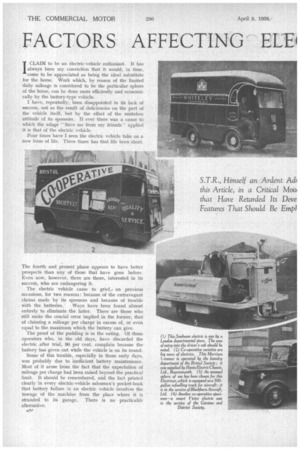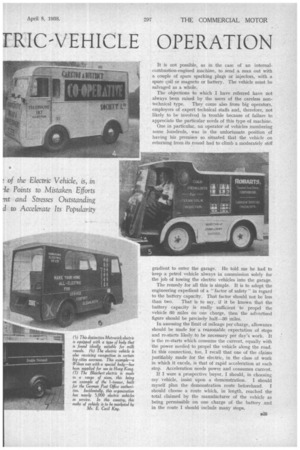FACTORS AFFECTING ELEI ERIC-VEHICLE OPERATION
Page 58

Page 59

Page 60

If you've noticed an error in this article please click here to report it so we can fix it.
ICLAIM to be an electric-vehicle enthusiast. It has always been my conviction that it would, in time. come to be appreciated as being the ideal substitute , for the horse. Work which, by reason of the limited daily mileage is considered to be the particular sphere of the horse, can be done more efficiently and economically by the battery-type vehicle.
I have, repeatedly, been disappointed in its lack of success, not as the result of deficiencies on the part of the vehicle itself, but by the effect of the mistaken attitude of its sponsors. If ever there was a cause to which the adage " Save me from my friends" applied it is that of the electric vehicle. , Four times have I seen the electric vehicle take on a new lease of life. Three times has that life been short.
The fourth and present phase appears to have better prospects than any of those that have gone before. Even now, however, there are those, interested in its success, who are endangering it.
The electric vehicle came to grief,on previous occasions, for two reasons: because of the extravagant claims made by its sponsors and because of trouble with the batteries. Ways have been found almost entirely to eliminate the latter. There are those who still make the crucial error implied in the former, that of claiming a mileage per charge in excess of, or even equal to the maximum which the battery can give.
The proof of the pudding is in the eating. Of those operators who, in the old days, have discarded the electric _after trial, 90 per cent. complain because the battery has given out while the vehicle is on its round.
Some of this trouble, especially in those early days, was probably due to inefficient battery maintenance. Most of it arose from the fact that the expectation of mileage per charge had been raised beyond the practical limit. It should be remembered, and the fact printed clearly in every electric-vehicle salesman's pocket-book that battery failure in an electric vehicle involves the towage of the machine from the place where it is stranded to its garage. There is no practicable alternative.
R91
It is not possible, as in the case of an internalcombustion-engined machine, to send a man out with a couple of spare sparking plugs or injectors, with a spare coil or magneto or battery. The vehicle must be salvaged as a whole.
The objections to which I have referred have not always been raised by the users of the careless nontechnical type. They come also from big operators, employers of expert technical staffs and, therefore, not likely to be involved in trouble because of failure to appreciate the particular needs of this type of machine. Qne in particular, an operator of vehicles numbering some hundreds, was in the unfortunate position of having his premises so situated that the vehicle on returning from its round had to climb a moderately stiff
gradient to enter the garage. He told me he had to keep a petrol vehicle always in commission solely for the job of towing the electric vehicles into the garage.
The remedy for all this is simple. It is to adopt the engineering expedient of a " factor of safety" in regard to the battery capacity. That factor should not be less than two. That is to say, if it be known that the battery capacity is really sufficient to propel the vehicle 60 miles on one charge, then the advertised figure should be precisely half-30 miles.
In assessing the limit of mileage per charge, allowance should be made for a reasonable expectation of stops and re-starts likely to be necessary per day's work. It is the re-starts which consume the current, equally with the power needed to propel the vehicle along the road. In this connection, too, I recall that one of the claims justifiably made for the electric, in the class of work in which it excels, is that of rapid acceleration at each stop. Acceleration needs power and consumes current.
If I were a prospective buyer, I should, in choosing my vehicle, insist upon a demonstration. I should myself plan the demonstration route beforehand. I should choose a route which, in length, reached the total claimed by the manufacturer of the vehicle as being permissible on one charge of the battery and in the route I should include many stops. When the demonstration was concluded. I should insist that the vehicle be run around the houses 'until it ceased to run, for the simple reason that the battery had ceased to function, I should measure the extra mileage thus covered and, if it did not nearly equal that of the demonstration run, I should specify a larger battery.
Protagonists of the electric vehicle are making an error of a similar character in connection with their publicity matter. They are showing, side by side, figures indi cating comparative cost of operation of petrol and electric vehicles, both being assumed to cover an annual mileage of 10,000. No acknowledgment is made of the fact that the petrol vehicle can, quite comfortably, increase the mileage by hundreds per cent., in which case the cost per mile would become very much less than that of the electric.
The mistake, in this procedure, lies in the incapacity of the average operator to appreciate the true meaning of the figures. He is just as likely as not to buy an elec tric on the basis of that cost-per-mile comparison and endeavour to use it in work involving bigger mileages.
It is true that it should be the business of the salesman to check any such tendency, even to the extent of refusing to sell. Not every salesman is able to resist the temptation to "faire a chance" on such a matter.
My recommendation is that when the comparative tables of costs are published they should be accompanied by a warning note to the effect that the figures apply only in reference to the annual mileage quoted, and that the electric vehicle is not suitable for any work in connection with which that mileage is at all likely to be exceeded.
Battery-charging Problems Overcome.
The other one-time cause of dissatisfaction with electrics has practically been eliminated. It arose in connection with maintenance and charging of batteries. Now, the user can buy, at small cost, a battery-charging plant which will charge his batteries in a most economical way. The outstanding advantage of this modern equipment is that it is safe to leave the batteries on charge over night without supervision.
Maintenance is now, the care of the battery manufacturers. They have taken it up wholeheartedly. A small army of inspectors makes periodic and free examinations of the batteries.
Essential service is rendered at reasonable prices. The operator has the alternative of buying the battery outright and entering into a battery-service contract, or of entering into a hire and maintenance contract under which batteries will be supplied and maintained for him at an annual rental. In this connection, it should be appreciated that the greater the number of those who enter into such maintenance contracts the less will be the cost to the individnal.
Broadly, the following are the conditions applying to the successful employment of electric vehicles. Careful consideration should be given to the work which it is
lashed to do and assurance made:that the work is really within the definitely hunted scope of this particularly useful type of machine. Insufficient attention to this matter and inefficient organization will resultsin failure to realize the advantages of the electric to its fullest extent. The biggest danger arises in connection with mixed fleets of petrol and electric vehicles.
The kind of thing that is likely to happen is this. In the transport operation of a large stores, it may happen that the transport manager is handed a consignmeut to be dispatched, as soon as possible, to a point 20 miles away. He promises that it shall be sent by the first available vehicle_ The first machine to return is an electric_ It cannot make the journey, because there is not a sufficient balance of charge in the battery to allow it to make the journey. The second to return is also an electric vehicle, and its arrival synchronizes with a note from the manager of the stores asking if the consignment has left, and, if not, why not. The traffic manager thereupon registers a vow to have no more electrics, wherein, of course, he is wrong. The blame lies with the organization in not arranging that suitable vehicles for emergency work shall always be available.
experience of Breweries an Object Lesson.
The experience of brewery companies is a lesson in 'this matter. They organize their transport so that the shortdistance deliveries, of a one-round-per-day type, are set apart to be worked by electric vehicles. Brewery companies, in London and in the provinces, have been using electrics for a score of years and are still doing so.
It should be appreciated that the mileage range depends upon the size of the battery in relation to the gross load, the nature of the country, i.e., whether hilly or flat, and whether the roads are good or bad. The number of stops and starts is a factor. It should be realized that makers of battery vehicles, in almost every case, offer each model in conjunction with alternative sizes of battery.
A fair average mileage capacity is 30 miles per day. Most tradesrhen's rounds, as in the delivery of bread, coal, milk or groceries, comprise little more than half that mileage, and are comparable with the work of collecting towns refuse, for which purpose electric vehicles have proved most suitable.
The ordinary tradesman operating a light van is, to-day, in a position to make as effective and trouble-free use of an electric vehicle as the most expertly equipped electrical department of a corporation. If he makes sure that the mileage he wishes to traverse be well within the capacity of the battery, if he purchases simple charging equipment and uses it intelligently, and if he enters into an arrangement to have his battery inspected and maintained, he can purchase an electric vehicle with the confidence that it will give him more economical service than he can get with any other form of transport, horse included, and that he will have the absolute minimum of trouble in its operation.






















































































































